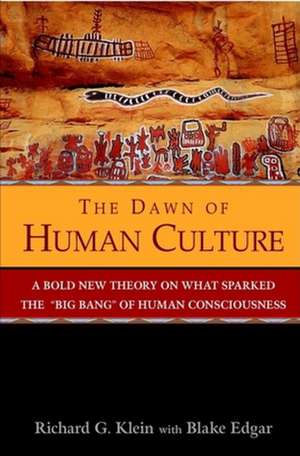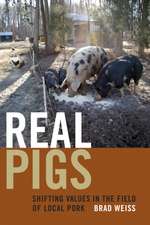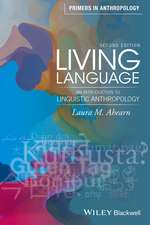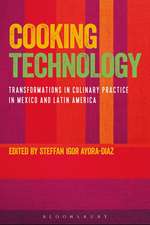The Dawn of Human Culture
Autor Richard G. Klein, Blake Edgaren Limba Engleză Hardback – 26 mar 2002
Richard G. Klein, PhD (Palo Alto, CA), is a Professor of Anthropology at Stanford University. He is the author of the definitive academic book on the subject of the origins of human culture, The Human Career. Blake Edgar (San Francisco, CA) is the coauthor of the very successful From Lucy to Language, with Dr. Donald Johanson. He has written extensively for Discover, GEO, and numerous other magazines.
Preț: 159.40 lei
Nou
Puncte Express: 239
Preț estimativ în valută:
30.50€ • 31.91$ • 25.34£
30.50€ • 31.91$ • 25.34£
Carte disponibilă
Livrare economică 13-27 martie
Preluare comenzi: 021 569.72.76
Specificații
ISBN-13: 9780471252528
ISBN-10: 0471252522
Pagini: 288
Dimensiuni: 164 x 240 x 25 mm
Greutate: 0.59 kg
Editura: Wiley (TP)
Locul publicării:Hoboken, United States
ISBN-10: 0471252522
Pagini: 288
Dimensiuni: 164 x 240 x 25 mm
Greutate: 0.59 kg
Editura: Wiley (TP)
Locul publicării:Hoboken, United States
Public țintă
General Science Readers, especially Readers of such magazines as National Geographic, Smithsonian, Natural History and Discover.Descriere
"The premier anthropologist in the country today."
–Evolutionary Anthropology on Richard Klein
"High above the western shore of Lake Naivasha, a blue pool on the parched floor of East Africa′s Great Rift Valley, sits a small rockshelter carved into the Mau Escarpment. Maasai pastoralists who once occupied this region in central Kenya called the place Enkapune Ya Muto, or ′Twilight Cave.′ People have long sought shelter there. The cave′s sediments record important cultural changes during the past few thousand years, including the first local experiments with agriculture and with sheep and goat domestication. Buried more than three meters deep in the sand, silt, and loam at Enkapune Ya Muto, however, lie the traces of an earlier and even more significant event in human prehistory. Tens of thousands of pieces of obsidian, a jet–black volcanic glass, were long ago fashioned into finger–length knives with scalpel–sharp edges, thumbnail–sized scrapers, and other stone tools, made on the spot at an ancient workshop. But what most impressed archeologist Stanley Ambrose were nearly six hundred fragments of ostrich eggshell, including thirteen that had been fashioned into disk–shaped beads about a quarter–inch in diameter. Forty thousand years ago, a person or persons crouched near the mouth of Enkapune Ya Muto to drill holes through angular fragments of ostrich eggshell and to grind the edges of each piece until only a delicate ring remained. Many shell fragments snapped in half under pressure from the stone drill or from the edge–grinding that followed. The craftspeople discarded each broken piece and began again with a fresh fragment of shell.
"Ambrose believes that these ancient beads played a key role in the survival strategy of the craftspeople and their families. In the Kalahari Desert of Botswana, !Kung San hunter–gatherers still practice a system of gift exchange known as hxaro. Certain items, such as food, are readily shared among the !Kung but never exchanged as gifts. The most appropriate gifts for all occasions just happen to be strands of ostrich eggshell beads. The generic word for gift is synonymous with the !Kung word for sewn beadwork. Although the nomadic !Kung carry the barest minimum of personal possessions, they invest considerable time and energy in creating eggshell beads.
"No one knows whether the toolmakers at Enkapune Ya Muto or the other ancient African sites intended their ostrich eggshell beads to be social gifts. But if these beads were invested with symbolic meaning similar to that of beads among the !Kung, then Twilight Cave may record the dawning of modern human behavior."
–From The Dawn of Human Culture
–Evolutionary Anthropology on Richard Klein
"High above the western shore of Lake Naivasha, a blue pool on the parched floor of East Africa′s Great Rift Valley, sits a small rockshelter carved into the Mau Escarpment. Maasai pastoralists who once occupied this region in central Kenya called the place Enkapune Ya Muto, or ′Twilight Cave.′ People have long sought shelter there. The cave′s sediments record important cultural changes during the past few thousand years, including the first local experiments with agriculture and with sheep and goat domestication. Buried more than three meters deep in the sand, silt, and loam at Enkapune Ya Muto, however, lie the traces of an earlier and even more significant event in human prehistory. Tens of thousands of pieces of obsidian, a jet–black volcanic glass, were long ago fashioned into finger–length knives with scalpel–sharp edges, thumbnail–sized scrapers, and other stone tools, made on the spot at an ancient workshop. But what most impressed archeologist Stanley Ambrose were nearly six hundred fragments of ostrich eggshell, including thirteen that had been fashioned into disk–shaped beads about a quarter–inch in diameter. Forty thousand years ago, a person or persons crouched near the mouth of Enkapune Ya Muto to drill holes through angular fragments of ostrich eggshell and to grind the edges of each piece until only a delicate ring remained. Many shell fragments snapped in half under pressure from the stone drill or from the edge–grinding that followed. The craftspeople discarded each broken piece and began again with a fresh fragment of shell.
"Ambrose believes that these ancient beads played a key role in the survival strategy of the craftspeople and their families. In the Kalahari Desert of Botswana, !Kung San hunter–gatherers still practice a system of gift exchange known as hxaro. Certain items, such as food, are readily shared among the !Kung but never exchanged as gifts. The most appropriate gifts for all occasions just happen to be strands of ostrich eggshell beads. The generic word for gift is synonymous with the !Kung word for sewn beadwork. Although the nomadic !Kung carry the barest minimum of personal possessions, they invest considerable time and energy in creating eggshell beads.
"No one knows whether the toolmakers at Enkapune Ya Muto or the other ancient African sites intended their ostrich eggshell beads to be social gifts. But if these beads were invested with symbolic meaning similar to that of beads among the !Kung, then Twilight Cave may record the dawning of modern human behavior."
–From The Dawn of Human Culture
Textul de pe ultima copertă
"The premier anthropologist in the country today."
–Evolutionary Anthropology on Richard Klein
"High above the western shore of Lake Naivasha, a blue pool on the parched floor of East Africa′s Great Rift Valley, sits a small rockshelter carved into the Mau Escarpment. Maasai pastoralists who once occupied this region in central Kenya called the place Enkapune Ya Muto, or ′Twilight Cave.′ People have long sought shelter there. The cave′s sediments record important cultural changes during the past few thousand years, including the first local experiments with agriculture and with sheep and goat domestication. Buried more than three meters deep in the sand, silt, and loam at Enkapune Ya Muto, however, lie the traces of an earlier and even more significant event in human prehistory. Tens of thousands of pieces of obsidian, a jet–black volcanic glass, were long ago fashioned into finger–length knives with scalpel–sharp edges, thumbnail–sized scrapers, and other stone tools, made on the spot at an ancient workshop. But what most impressed archeologist Stanley Ambrose were nearly six hundred fragments of ostrich eggshell, including thirteen that had been fashioned into disk–shaped beads about a quarter–inch in diameter. Forty thousand years ago, a person or persons crouched near the mouth of Enkapune Ya Muto to drill holes through angular fragments of ostrich eggshell and to grind the edges of each piece until only a delicate ring remained. Many shell fragments snapped in half under pressure from the stone drill or from the edge–grinding that followed. The craftspeople discarded each broken piece and began again with a fresh fragment of shell.
"Ambrose believes that these ancient beads played a key role in the survival strategy of the craftspeople and their families. In the Kalahari Desert of Botswana, !Kung San hunter–gatherers still practice a system of gift exchange known as hxaro. Certain items, such as food, are readily shared among the !Kung but never exchanged as gifts. The most appropriate gifts for all occasions just happen to be strands of ostrich eggshell beads. The generic word for gift is synonymous with the !Kung word for sewn beadwork. Although the nomadic !Kung carry the barest minimum of personal possessions, they invest considerable time and energy in creating eggshell beads.
"No one knows whether the toolmakers at Enkapune Ya Muto or the other ancient African sites intended their ostrich eggshell beads to be social gifts. But if these beads were invested with symbolic meaning similar to that of beads among the !Kung, then Twilight Cave may record the dawning of modern human behavior."
–From The Dawn of Human Culture
–Evolutionary Anthropology on Richard Klein
"High above the western shore of Lake Naivasha, a blue pool on the parched floor of East Africa′s Great Rift Valley, sits a small rockshelter carved into the Mau Escarpment. Maasai pastoralists who once occupied this region in central Kenya called the place Enkapune Ya Muto, or ′Twilight Cave.′ People have long sought shelter there. The cave′s sediments record important cultural changes during the past few thousand years, including the first local experiments with agriculture and with sheep and goat domestication. Buried more than three meters deep in the sand, silt, and loam at Enkapune Ya Muto, however, lie the traces of an earlier and even more significant event in human prehistory. Tens of thousands of pieces of obsidian, a jet–black volcanic glass, were long ago fashioned into finger–length knives with scalpel–sharp edges, thumbnail–sized scrapers, and other stone tools, made on the spot at an ancient workshop. But what most impressed archeologist Stanley Ambrose were nearly six hundred fragments of ostrich eggshell, including thirteen that had been fashioned into disk–shaped beads about a quarter–inch in diameter. Forty thousand years ago, a person or persons crouched near the mouth of Enkapune Ya Muto to drill holes through angular fragments of ostrich eggshell and to grind the edges of each piece until only a delicate ring remained. Many shell fragments snapped in half under pressure from the stone drill or from the edge–grinding that followed. The craftspeople discarded each broken piece and began again with a fresh fragment of shell.
"Ambrose believes that these ancient beads played a key role in the survival strategy of the craftspeople and their families. In the Kalahari Desert of Botswana, !Kung San hunter–gatherers still practice a system of gift exchange known as hxaro. Certain items, such as food, are readily shared among the !Kung but never exchanged as gifts. The most appropriate gifts for all occasions just happen to be strands of ostrich eggshell beads. The generic word for gift is synonymous with the !Kung word for sewn beadwork. Although the nomadic !Kung carry the barest minimum of personal possessions, they invest considerable time and energy in creating eggshell beads.
"No one knows whether the toolmakers at Enkapune Ya Muto or the other ancient African sites intended their ostrich eggshell beads to be social gifts. But if these beads were invested with symbolic meaning similar to that of beads among the !Kung, then Twilight Cave may record the dawning of modern human behavior."
–From The Dawn of Human Culture
Cuprins
Preface.
Chapter 1: Dawn at Twilight Cave.
Chapter 2: Bipedal Apes.
Chapter 3: The World′s Oldest Whodunit.
Chapter 4: The First True Humans.
Chapter 5: Humanity Branches Out.
Chapter 6: Neanderthals Out on a Limb.
Chapter 7: Body before Behavior.
Chapter 8: Nurture of Nature Before the Dawn?
Appendix: Placing Ancient Sites in Time.
Selected Further Reading.
Index.
Chapter 1: Dawn at Twilight Cave.
Chapter 2: Bipedal Apes.
Chapter 3: The World′s Oldest Whodunit.
Chapter 4: The First True Humans.
Chapter 5: Humanity Branches Out.
Chapter 6: Neanderthals Out on a Limb.
Chapter 7: Body before Behavior.
Chapter 8: Nurture of Nature Before the Dawn?
Appendix: Placing Ancient Sites in Time.
Selected Further Reading.
Index.
Recenzii
"...a compelling story...it′s a tale worth reading..." (Focus, July 2002)
"...a compelling story...it′s a tale worth reading..." (Focus, July 2002)
"...a compelling story...it′s a tale worth reading..." (Focus, July 2002)
Notă biografică
Richard G. Klein, Ph.D., is Professor of Anthropology at Stanford University. He is the author of the definitive scholarly book on human evolution, The Human Career.
Blake Edgar is a science editor at the University of California Press and the coauthor with Donald Johanson of From Lucy to Language. He has written for Discover, Scientific American, GEO, and numerous other magazines.
Blake Edgar is a science editor at the University of California Press and the coauthor with Donald Johanson of From Lucy to Language. He has written for Discover, Scientific American, GEO, and numerous other magazines.








